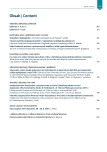Secondary dyslipidemia
Authors:
Martin Šatný; Michal Vrablík
Authors‘ workplace:
III. interní klinika – klinika endokrinologie a metabolismu 1. LF a VFN v Praze
Published in:
AtheroRev 2017; 2(3): 162-168
Category:
Reviews
Overview
Secondary dyslipidemia (DLP) arises as a result of other diseases or various exogenous influences. However, genetic predisposition, as it is known in the case of primary DLP, plays an important role in the development secondary DLP, too. Typical examples are patients with hypothyroidism, when not all of these patients develop DLP. Another fact that supports genetic background is the individual sensitivity of lipid metabolism to exogenous influences and lifestyle. Secondary DLPs are most commonly observed in a variety of endocrinopathies (hypothyroidism, Cushing‘s syndrome), diabetes mellitus, chronic kidney disease, liver disease, autoimmune disease, alcohol abuse etc. Moreover, DLPs can be caused by drugs, e.g. diuretics, non-selective beta-blockers, immunosuppressants and others. Physiological secondary DLP can be observed during pregnancy. Secondary DLP exclusion is a logical first step of assessment of a patient with DLP. Treatment with lipid lowering drugs would not be indicated when causal therapy exists. The eventual initiation of hypolipidemic treatment is based the type of DLP and its inducing factors.
Key words:
alcohol, diabetes mellitus, drug dyslipidemia, endocrinopathy, chronic kidney disease, chronic liver disease, obesity, secondary dyslipidemia
Sources
1. Soška V. Familiární hypercholesterolemie: Dovedeme ji správně diagnostikovat? Vnitř Lék 2000; 46(1): 19–23.
2. Vodnala D, Rubenfire M, Brook RD. Secondary causes of dyslipidemia. Am J Cardiol 2012; 110(6): 823–825. Dostupné z DOI: <http://dx.doi.org/10.1016/j.amjcard.2012.04.062>.
3. Ross DS. Lipid abnormalities in thyroid diseases. Cooper DS, Mulder JE (eds). UpToDate 2013. Dostupné z WWW: <https://www.uptodate.com/contents/lipid-abnormalities-in-thyroid-disease?source=search_result&search=lipid+abnormalities+in+thyroid+disease&selectedTitle=1~150>.
4. Duntas LH. Thyroid disease and lipids. Thyroid 2002; 12(4): 287–293.
5. Iyengar SS, Puri R, Narasingan SN. Lipid Association of India Expert Consensus Statement on Management of Dyslipidemia in Indians 2016: Part 1 – Executive summary. J Clin Prev Cardiol 2016; 5(2): 51–61. Dostupné DOI: <http://dx.doi.org/10.4103/2250–3528.186492>.
6. Jiskra J. Změny svalové tkáně u hypothyreózy. Vnitř Lék 2001; 47(9): 609–612.
7. Vrablík M, Češka R. Sekundární dyslipoproteinémie. Interní medicína pro praxi 2003; 5(6): 285–390. Dostupné z WWW: <https://www.internimedicina.cz/pdfs/int/2003/06/04.pdf>.
8. Zdravotnická ročenka České republiky 2015. Ústav zdravotnických informací a statistiky České republiky: Praha 2016. ISSN 1210–9991.
9. Soška V. Sekundární dyslipidemie a jejich léčba. Vnitř Lék 2007; 53(4): 396–400.
10. Chehade JM. Gladysz M, Mooradian AD. Dyslipidemia in Type 2 Diabetes: Prevalence, Pathophysiology, and Management. Drugs 2013; 73(4): 327–339. Dostupné z DOI: <http://dx.doi.org/10.1007/s40265–013–0023–5>.
11. Feingold KR, Grunfeld C. Obesity and Dyslipidemia. [Updated 2015 Jun 12]. In: De Groot LJ, Chrousos G, Dungan K et al (eds). Endotext [Internet]. MDText.com, Inc: South Dartmouth (MA) 2000. Dostupné z WWW: <https://www.ncbi.nlm.nih.gov/books/NBK305895/.
12. Catapano AL, Graham I, De Backer G et al. 2016 ESC/EAS Guidelines for the Management of Dyslipidaemias. Eur Heart J 2016; 37(39), 2999–3058. Dostupné z DOI: 13. Hannuksela ML, Liisanantt MK, Savolainen MJ. Effect of alcohol on lipids and lipoproteins in relation to atherosclerosis. Crit Rev Clin Lab Sci 2002; 39(3): 225–283.
14. Haj Mouhamed D, Ezzarhar A, Neffati F et al. Association between cigarette smoking and dyslipidemia. Immuno-analyse et biologie spécialisée 2013; 28(4): 195–200. Dostupné z WWW: <http://linkinghub.elsevier.com/retrieve/pii/S0923253213000306>.
15. 15. Rosenson RS. Secondary causes of dyslipidemia. Wolters Kluwer N.V. UpToDate. Dostupné z WWW: <https://www.uptodate.com/contents/secondary-causes-of-dyslipidemia?>.
16. Weiner DE, Sarnak MJ. Managing dyslipidemia in chronic kidney disease. J Gen Intern Med 2004; 19(10):1045.
17. Radhakrishnan J (2015). Lipid abnormalities in nephrotic syndrome. In Glassock JG, Rovin BBH, Lam AQ (eds). UpToDate. Dostupné z WWW: <http://www.uptodate.com/contents/lipid-abnormalities-in-nephrotic-syndrome?source=search_result&search=lipid+abnormalities+in+nephrotic+syndrome&selectedTitle=1~150>.
18. Kronenberg F, Lingenhel A, Lhotta Ket al. Lipoprotein(a) - and low-density lipoprotein-derived cholesterol in nephrotic syndrome: Impact on lipid-lowering therapy? Kidney Int 2004; 66(1): 348–354.
19. Yamauchi A, Fukuhara Y, Yamamoto S et al. Oncotic pressure regulates gene transcriptions of albumin and apolipoprotein B in cultured rat hepatoma cells. Am J Physiol 1992; 263(2 Pt 1): C397-C404.
20. Joles JA, Bijleveld C, van Tol A et al. Plasma triglyceride levels are higher in nephrotic than in analbuminemic rats despite a similar increase in hepatic secretion. Kidney Int 1995; 47(2): 566–572.
21. Clement LC, Macé C, Avila-Casado C et al. Circulating angiopoietin-like 4 links proteinuria with hypertriglyceridemia in nephrotic syndrome. Kidney Int 1993; 44(3): 638.
22. Mikolasevic I, Žutelija M, Mavrinac V et al. Dyslipidemia in patients with chronic kidney disease: etiology and management. Int J Nephrol Renovasc Dis [online]. 2017; 10 : 35–45. Dostupné z DOI: <http://dx.doi.org/10.2147/IJNRD.S101808>.
23. Studeník P. Poruchy metabolismu lipidů u jaterních onemocnění. Vnitr Lek 2000; 46(9): 547–548.
24. Nemes K, Åberg F, Gylling H et al. Cholesterol metabolism in cholestatic liver disease and liver transplantation: From molecular mechanisms to clinical implications. World JHepatol [online] 2016; 8(22), 924–932. Dostupné z DOI: <http://dx.doi.org/10.4254/wjh.v8.i22.924>.
25. Herink M, Ito MK. Medication Induced Changes in Lipid and Lipoproteins. [Updated 2015 Jul 27]. In: De Groot LJ, Chrousos G, Dungan K et al (eds). Endotext [Internet]. MDText.com, Inc: South Dartmouth (MA) 2000. Dostupné z WWW: <https://www.ncbi.nlm.nih.gov/books/NBK326739/>.
Labels
Angiology Diabetology Internal medicine Cardiology General practitioner for adultsArticle was published in
Athero Review

2017 Issue 3
- Memantine Eases Daily Life for Patients and Caregivers
- Metamizole vs. Tramadol in Postoperative Analgesia
- What Effect Can Be Expected from Limosilactobacillus reuteri in Mucositis and Peri-Implantitis?
- Advances in the Treatment of Myasthenia Gravis on the Horizon
- The Importance of Hydration in Wound Healing
Most read in this issue
- Secondary dyslipidemia
- Intensive treatment of dyslipidemia in regional outpatient cardiology office
- Opinion of the Committee of the Czech Society for Atherosclerosis on the ESC/ EAS Recommendations for Dyslipidemia Diagnostics and Treatment 2016
- What do we know and what can we really do for families with familial hypercholesterolemia: case report
